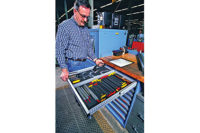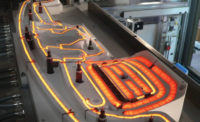Mixed technology printed circuit boards (PCBs) can be complex. They are often assembled using a double-sided surface mount reflow process. Wave soldering at the end attaches the through-hole components. Typically, the wave soldering process requires a pallet to protect the surface mount components that have been mounted. These pallets are often thick, making it difficult for the wave solder to flow effectively and create an acceptable through-hole solder joint.
First pass yields as low as 10 percent are not uncommon with this process. The resulting rework is expensive and can cause reliability problems if not correctly performed.
If the profit margin on the PCB is low, operating and maintaining a wave soldering machine can make assembling the product cost-prohibitive.
The Pin-in-Paste Process
The pin-in-paste (PIP) process can often replace wave soldering. With PIP, the surface mount reflow process should produce acceptable through-hole solder joints that comply with IPC standards. The joint should have no voids and possess a fillet.The typical PIP process is incorporated into the surface mount process. This approach requires the following:
- The stencil will be designed so that the correct amount of solder paste can be printed onto the through-holes to form an acceptable joint after reflow.
- The solder paste will be amenable to the PIP process.
- The stencil printing process should be optimized.
- Through-hole components will be selected so they can withstand reflow soldering temperatures.
- Leads should be rounded at the end and be the correct length to form a good solder joint.
- Through-hole components will be mounted correctly.
- The reflow profile will be acceptable.
Stencil Design
Stencil design is a challenging element in the PIP process. The stencil must deliver the correct amount of solder paste to the through-hole during the stencil printing process. To achieve this goal, the amount of solder needed must be determined.The volume of solder in the through-hole solder joint, VSJ equals the volume of the through-hole, Vh, plus the volume of the fillet, Vf, minus the volume of the pin, Vp. The Pappus-Guldin theorem for volumes of revolution determines the volume of the fillet. Therefore, the solder joint volume is:
Equation 1: VSJ = Vh + Vf - Vp
The amount of solder paste to be printed, VSP, is not the same as solder joint volume, because solder paste is only about 50 percent solder by volume. So the solder paste needed is:
Equation 2: VSP = VSJ / F
F is the solder paste reduction factor, which is typically between 0.45 and 0.55.
The stencil aperture must be designed so that it provides the needed solder paste volume. If the aperture is circular, the solder paste volume will be:
Equation 3: VSP = pr2 t
Where r is the aperture radius and t is the stencil thickness, the aperture radius and stencil thickness must be such that Equation 3 is satisfied.
If the aperture is rectangular, the equation for solder paste volume becomes:
Equation 4: VSP = l w t
Aperture length is l, and w is its width.
For example, if the board thickness is 56 mils, the pin diameter is 18 mils, the hole diameter is 30 mils and the solder pad diameter is 78 mils, then the solder fillet volume for both sides is 38,181 cubic mils, the hole volume is 39,584 cubic mils, the pin displacement is 14,250 cubic mils, the solder joint volume is 63,515 cubic mils and the paste volume is 127,030 cubic mils.
Assuming a 7-mil-thick stencil is used, the side of a square aperture has to be 135 mils to provide the right solder paste amount. If the apertures are circular, a 76-mil radius will be required.
For PCBs with fine-pitch through-hole components, rectangular apertures will be required to obtain the desired solder paste volume.
In some cases one stencil thickness cannot satisfy the needs for PIP and other components. It may be necessary to print twice with two separate stencils or use a step stencil.1
Calculating stencil designs for a PCB can be cumbersome. Stencil Coach software enables rapid calculation of PIP stencil parameters.2
Solder Paste
Choosing the correct solder paste is a crucial element of a successful PIP process. Because solder paste is printed on one side of the substrate, the paste has to wet through the board opening and to the end of the component’s pins. This wetting activity is process- and product-dependent. Although there are some exceptions, Type 3 solder powder is acceptable for PIP applications.
No-clean and water-soluble solder pastes can also be used in the PIP process. However, no-clean solder paste is probably the preferred paste for cleanability reasons. When using solder paste to assemble a through-hole component, more flux residue is left behind than with wave soldering. This thick layer of flux residue is more difficult to clean than residue around surface mount components. The component can also shield the flux residue from the cleaning water pressure, making it a less effective cleaning process for through-hole components.
Stencil Printing
For PIP to be successful, the stencil printing process requires a delicate balance between the needs for surface mount and through-hole components. The stencil printer should deposit a sufficient amount of solder paste on the through-hole pads without printing an excess amount on the fine-pitch surface mount pads. Although the printer parameters are process-dependent, some important variables include:Pressure: As the squeegee blade pressure is increased, more solder paste is forced into the hole. The more solder paste that is deposited, the more robust the through-hole joint will be. If the pressure is increased too much, bridging will occur on fine pitch surface mount pads. In addition, higher pressure will require the bottom of the stencil to be wiped more frequently.
Print Speed: The squeegee print speed should be adjusted in conjunction with the squeegee pressure. A slower print speed will fill the apertures more completely, which results in more solder paste being deposited.
The emergence of enclosed print head technology (e.g.., DEK Proflow, MPM Rheometric Pump) allows the assembler to further improve the PIP process. Studies show that the direct downward force used by these systems forces more paste into the hole than standard squeegee blades. The increased amount of solder paste being deposited helps achieve a more complete fillet and more robust solder joint.
Component Concerns
Obviously, the components need to withstand the temperature of the reflow process. This information should be available from component vendor specification sheets.
The right amount of solder paste must remain in the holes to form good solder joints. Therefore, the component pins must not be allowed to push the solder paste completely out of the through-hole. To avoid this problem, component leads should not protrude more than 60 mils from the bottom of the PCB. The leads should also be rounded. Rounded leads minimize solder paste "push through."
Placement
Most assemblers find that hand mounting works best for PIP. However, operators must not disturb previously mounted surface mount components. The through-hole components should be inserted so that the pins do not protrude more than 60 mils from the bottom of the board. Care must also be taken if the through-hole components have mounting supports that snap into the board. The snapping may shake the board and dislodge surface mount components.Reflow
Assemblers might first try the reflow profile proposed by Lee3. It may produce higher yields. This profile has a gentle ramp up of 0.5 to 1 C per second, a slight dwell at the liquidus temperature, a minimum time above liquidus and a rapid ramp down, but less than 4 C per second.
This profile is designed for modern convection reflow ovens and can minimize many soldering defects, such as solder balling. For the PIP process, the gentle ramp minimizes any viscosity drop in the solder paste due to heat input. The higher viscosity reduces the chance for the solder paste to drip off the component during the oven’s initial heating stages.
Process Optimization
This article should give readers reasonable starting points for the PIP process. It should always be understood that designed experiments are usually required to optimize any process. Once the process is optimized, statistical process control techniques should be used for process control.Presented at the SMTA National Conference

